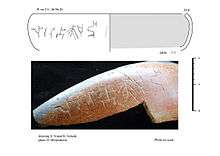Tissamaharama Tamil Brahmi inscription

Tissamaharama Tamil Brahmi inscription refers to a fragment of black and red ware flat dish inscribed in Tamil in the Tamil Brahmi script excavated at the earliest layer in southern town of Tissamaharama in Sri Lanka. It is dated to approximately 200 BC by German scholars who undertook the excavation. The inscription is mix of Brahmi letters and Graffiti symbols. The words are read from right to left and from left to right to mean thiraLi muRi. There are conflicting interpretations of what is read as inscribed.[1][2] The Tamilnet new site reported that the inscribed pottery was potentially misplaced or lost.[3]The Daily Mirror newspaper in an Op-ed page reported that the local archeologists have not seen the artifact for review.[4]
The inscription
The inscription is a combination of readable Brahmi and Megalithic graffiti symbols that are usually found in megalithic and early historic pottery in South India and Sri Lanka. From left to right, the first three are Brahmi letters, the next two are symbols and it is followed by two letters in Brahmi. There is a vertical line, away from the legend that may mark the end of the legend. Archeologist and etymologist, P. Ragupthy and epigraphist Iravatham Mahadevan both read the inscription as thiraLi muRi.[1][2] According archeologist Somadeva of Sri Lanka, the artifact is confirmed to be Tamil Brahmi.[5]
From left to right, the first letter of the legend is Tamil Brahmi Li which is a palatal L. As no word begins with this letter in Tamil, Sinhala, Prakrit or Sanskrit, the word is read by Mahadevan by reading the three letters placed left to the symbols from right to left as tiraLi.[1][2]
The last letter of the legend as read from left to right is a Tamil Brahmi Ri which is a retroflex R. Retroflex R which is a unique phoneme found in Tamil and other related Dravidian languages but is also found in Indo-Aryan Prakrit inscriptions in Sri Lanka.[6] Mahadevan reads the last two letters placed right to the symbols from left to right as ‘muRi’.[1][2] It is the oldest dated Tamil Brahmi inscription in the world with the exception of the Tamil Brahmi inscriptions found in Palani in Southern India scientifically dated to 540 BCE - the oldest known Brahmi inscriptions on the Indian sub-continent.[7]
Direction of reading
According to P. Ragupathy Brahmi is usually written from left to right but in few occasions Tamil Brahmi was found to be written from right to left in Tamil Nadu.[8] In Sri Lanka, some examples have been found in which Brahmi was written from right to left as well.[9] But what is unique is this inscription is partly read from right to left and partly read from left to right, keeping symbols in the middle.[2]
Trade guild versus vessel for rice
Mahadevan reads the meaning of Tirali Muri as written agreement of the assembly. He further postulates that it indicates the presence of a Tamil trade guild in Southern Sri Lanka in the 2nd century BCE.[1] But P. Ragupathy reads it as indicating a vessel specified for the purpose of serving rice portions. He postulates that it indicates the presence of common people not a trade guild.[2]
Notes
- 1 2 3 4 5 Mahathevan, Iravatham (24 June 2010). "An epigraphic perspective on the antiquity of Tamil". The Hindu. The Hindu Group. Retrieved 31 October 2010.
- 1 2 3 4 5 6 Ragupathy, P (28 June 2010). "Tissamaharama potsherd evidences ordinary early Tamils among population". Tamilnet. Tamilnet. Retrieved 31 October 2010.
- ↑ "Tissamaharama Tamil Brahmi inscription 'missing'". Tamilnet. Tamilnet. 10 October 2010. Retrieved 31 October 2010.
- ↑ Goonatilake, Susantha (21 October 2010). "Fictional LTTE Archeology continues". The Daily Mirror. Wijeya Newspapers Ltd. Retrieved 1 November 2010.
- ↑ http://www.archaeology.lk/http:/www.archaeology.lk/wp-content/uploads/2011/02/Dinithi-Volume-1-Issue-4.pdf
- ↑ Mahadevan 2003, p. 195
- ↑ Subramaniam, T.S (29 August 2011). "Palani excavation triggers fresh debate". The Hindu. The Hindu. Retrieved 7 October 2011.
- ↑ Mahadevan 2003, pp. 179–180
- ↑ Mahadevan 2003, p. 180
References
- Mahadevan, Iravatham (Nov 30, 2003). Early Tamil Epigraphy from the Earliest Times to the Sixth Century A.D. Department of Sanskrit and Indian studies. ISBN 0-674-01227-5.